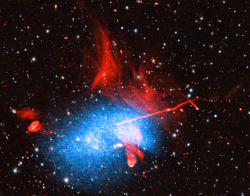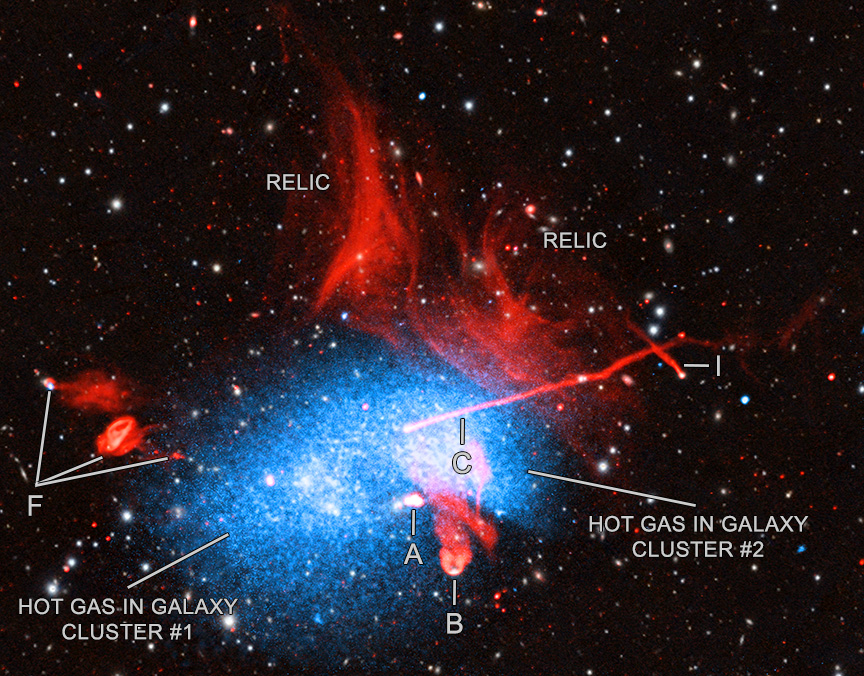Find out the latest thinking about our universe.
-
bystander
- Apathetic Retiree
- Posts: 21577
- Joined: Mon Aug 28, 2006 2:06 pm
- Location: Oklahoma
Post
by bystander » Wed Mar 08, 2023 4:43 pm
 Reconstructing a Cluster Collision
Reconstructing a Cluster Collision
Clusters of galaxies contain hundreds or thousands of individual galaxies, held together by the mutual binding gravity of their
dark matter haloes. Clusters are dynamic, with member galaxies swarming around the common center of mass, and often colliding. Encounters between individual galaxies help drive the high-energy outbursts of the supermassive black holes that most of the galaxies possess and thereby shape the basic building blocks of the
structure of the Universe on the largest scales. Even more powerful are collisions between entire clusters of galaxies themselves. A particularly important example of a galaxy cluster collision is the system
Abell 2256, a relatively nearby cluster composed of at least three sub-clusters which are falling together. The image above is a composite of Abell 2256 which includes X-ray emission imaged by the
Chandra X-ray Observatory and
XMM-Newton (in blue), radio images from the
Giant Metrewave Radio Telescope (GMRT), the
Low Frequency Array (LOFAR), and the
Karl G. Jansky Very Large Array (VLA) (n red), and optical and infrared data from
Pan-STARRS (in white and pale yellow). These multi-wavelength studies are vital to produce a full picture of all the energetic process going on when clusters collide. X-ray emission shows the hottest gas which contains most of the mass of atoms and atomic nuclei in the cluster (containing more mass than all the stars in all the cluster galaxies). Optical emission localizes the individual galaxies and reveals the types of stars they contain. Radio emission traces the history of the activity of the supermassive black holes in the cluster, and to reveal how old shocked debris on the outskirts of the collision, in combination with the cluster magnetic field, can accelerate particles to nearly the speed of light. A number of these major features are labelled in the image.
NASA: Chandra: Untangling a Knot of Galaxy Clusters
Know the quiet place within your heart and touch the rainbow of possibility; be
alive to the gentle breeze of communication, and please stop being such a jerk. — Garrison Keillor
-
bystander
- Apathetic Retiree
- Posts: 21577
- Joined: Mon Aug 28, 2006 2:06 pm
- Location: Oklahoma
Post
by bystander » Wed Mar 08, 2023 5:11 pm
Abell 2256: Untangling a Knot of Galaxy Clusters
X-ray: Chandra: NASA/CXC/Univ. of Bologna/K. Rajpurohit et al;
XMM-Newton: ESA/XMM-Newton/Univ. of Bologna/K. Rajpurohit et al;
Radio: LOFAR/ASTRON; NCRA/TIFR/GMRT; NSF/NRAO/VLA; Optical/IR: Pan-STARRS Astronomers have captured a spectacular, ongoing collision between at least three galaxy clusters. Data from NASA’s Chandra X-ray Observatory, ESA’s (European Space Agency’s) XMM-Newton, and a trio of radio telescopes is helping astronomers sort out what is happening in this jumbled scene. Collisions and mergers like this are the main way that galaxy clusters can grow into the gigantic cosmic edifices seen today. These also act as the largest particle accelerators in the universe.
The giant galaxy cluster forming from this collision is Abell 2256, located 780 million light-years from Earth. This composite image of Abell 2256 combines X-rays from Chandra and XMM in blue with radio data collected by the Giant Metrewave Radio Telescope (GMRT), the Low Frequency Array (LOFAR), and the Karl G. Jansky Very Large Array (VLA) all in red, plus optical and infrared data from Pan-STARRs in white and pale yellow.
Astronomers studying this object are trying to tease out what has led to this unusual-looking structure. Each telescope tells a different part of the story. Galaxy clusters are some of the biggest objects in the universe containing hundreds or even thousands of individual galaxies. In addition, they contain enormous reservoirs of superheated gas, with temperatures of several million degrees Fahrenheit. Only X-ray telescopes like Chandra and XMM can see this hot gas. A labeled version of the figure shows gas from two of the galaxy clusters, with the third blended too closely to separate from the others. ...
Deep low-frequency radio observations of Abell 2256.
I: The filamentary radio relic ~ K. Rajpurohit
et al
Deep low-frequency radio observations of Abell 2256.
II: The ultra-steep spectrum radio halo ~ K. Rajpurohit
et al
Know the quiet place within your heart and touch the rainbow of possibility; be
alive to the gentle breeze of communication, and please stop being such a jerk. — Garrison Keillor
 Reconstructing a Cluster Collision
Reconstructing a Cluster Collision

